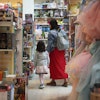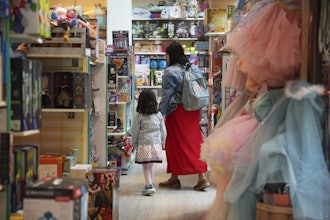
WASHINGTON (AP) — Nearly 1.9 million people applied for U.S. unemployment benefits last week, evidence that many employers are still cutting jobs even as the gradual reopening of businesses has slowed the pace of layoffs.
The total number of people who are receiving jobless aid rose slightly to 21.5 million, down from a peak of nearly 25 million two weeks ago but still at a historically high level. It shows that scattered rehiring is offsetting only some of the ongoing layoffs with the economy mired in a recession. Thursday's latest weekly number from the Labor Department is still more than double the record high that prevailed before the viral outbreak.
Still, the number of people who applied for benefits last week marked the ninth straight decline since applications spiked in mid-March. The job market meltdown that was triggered by the coronavirus may have bottomed out as more companies call at least some of their former employees back to work.
Economists said they were disappointed, though, that the number of first-time applications for jobless aid and the total number of people receiving benefits remain so high.
“While the drop in new claims is welcome news and more evidence that the worst of the job losses are behind us, the recovery in the labor market is expected to be painfully slow,” said Gregory Daco, chief U.S. economist at Oxford Economics. “We look for a two-phase recovery, with an initial burst in rehiring followed by a much slower retracement of job losses.
Fewer people sought jobless aid last week in 47 states and in Washington, D.C., while the number rose in just California, Florida and Mississippi. The total number of people receiving aid fell in 37 states and in D.C. and increased in 13 states.
Applications for jobless benefits are falling in states that had reopened their businesses early, such as Georgia and Texas, and are also declining in those that are still early in the reopening process, such as New York and Massachusetts.
Some businesses that have reopened have seen only a limited number of customers so far.
In Chattanooga, Tennessee, Nneka Ijeoma lost her job as a bartender at a whiskey bar when it closed in March. Though the bar has reopened, it has rehired only two of its 17 employees. Meanwhile, Ijeoma is receiving $275 in state unemployment benefits each week, plus $600 a week in federal benefits
“We were honestly so blessed by that,” she said of the federal aid, which will expire at the end of July. “I wouldn’t have been able to get by on $275.”
Still, she is eager to return to work and to go back to school in the fall to finish her college degree. Yet she always regarded bartending as a long-term opportunity.
“I always thought I could work in hospitality forever,” she said. “I thought it was recession-proof.”
In addition to the laid-off employees who applied for benefits last week, 623,000 others sought jobless aid under a new program for self-employed and gig workers, who now qualify for unemployment benefits for the first time. These figures aren’t adjusted for seasonal variations, so the government doesn’t include them in the overall data. And 15 states still aren’t reporting the number of applicants under this program, meaning that the data is incomplete.
The figures come one day before the government’s jobs report for May is expected to show that employers slashed 8 million jobs last month and that the unemployment rate jumped from 14.7% to 19.8%. If those forecasts prove accurate, it would mean that nearly 30 million people have lost jobs since the viral outbreak intensified in March and that joblessness has reached its highest point since the Great Depression.
Since mid-March, 42.7 million people have applied for unemployment benefits. Not all of them are still unemployed, though. Some have since been rehired. And some laid-off people likely filed duplicate applications for benefits as they struggled with unresponsive state unemployment systems. Others were unable to file their applications at all until recently.
“The big question is whether millions are still filing for unemployment due to separations that happened awhile ago or because of separations still happening today,” said Adam Ozimek, chief economist at Upwork. “The latter is far more problematic” because it would point to ongoing business closures and cutbacks.
Thursday’s report wasn’t affected by the protests over the killing of George Floyd, which in recent days forced some major retailers and small businesses to close, because it covers claims filed only through May 30. But some economists warn that applications for unemployment aid could rise in next week’s report, reflecting business closures amid the protests and scattered vandalism.
“That’s going to kick up the claims again,” said Jane Oates, a former Labor Department official.
The depth of the job cuts since the virus forced the widespread shutdown of businesses reflects an economy gripped by the worst downturn since the Great Depression. The economy is thought to be shrinking in the April-June quarter at an annual rate approaching 40%. That would be, by far, the worst quarterly contraction on record.
Still, real-time private data on consumer behavior is showing signs that the economy is gradually reviving. Credit and debit card spending tracked by Chase Bank shows that consumer spending, though roughly flat last week, rebounded from its low point in mid-April, when it was 40% below year-ago levels. Now, it is down 20% from a year ago.
Economists caution that most Americans will need to feel more confident about returning to their former habits of shopping, traveling and eating out before the economy can sustain any meaningful recovery. That will likely require the availability of a vaccine or a significant increase in testing.
“What’s really going to move the needle economically is when consumers and businesses feel comfortable re-engaging with the economy the way they did before COVID-19,” said Adam Kamins, a senior regional economist at Moody’s Analytics.






















